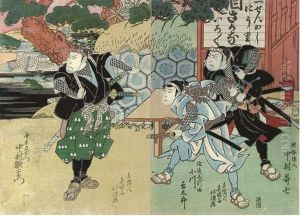Hokushu Paintings
Shunkosai Hokushu, commonly referred to as Hokushu, was a prominent Japanese artist known for his ukiyo-e woodblock prints, specifically in the genre of yakusha-e, which focuses on portraits of kabuki actors. Born in 1771, Hokushu was active during the late Edo period, a time when the ukiyo-e art form flourished in Japan, particularly in the cultural hub of Edo (modern-day Tokyo).
Hokushu was a pupil of the renowned artist Shunko, who was also specialized in the yakusha-e genre. Hokushu's work is characterized by dynamic compositions and a strong use of line, capturing the expressive qualities and the dramatic flair of kabuki theater. He was skilled in portraying the theatrical makeup and elaborate costumes that were trademarks of the kabuki stage, and his prints are valued for their historical depiction of the actors and performances of the time.
During his career, Hokushu also produced works that included sumo wrestlers and scenes from Japanese mythology and folklore. His prints often include actor's names and the roles they played, which have become valuable resources for the study of kabuki during the Edo period. Hokushu's artistic output contributed to the development of the Osaka school of ukiyo-e, where he worked alongside other artists such as Ashiyuki and Sadamasu.
Hokushu's influence extended beyond his lifetime, as his prints continued to be appreciated for their vivid detail and the insight they provide into the cultural life of Edo-period Japan. Hokushu died in 1832, but his work remains an important part of the history of Japanese art and is studied by scholars and enjoyed by collectors around the world. His prints are held in the collections of major museums and are considered important cultural artifacts that offer a window into the popular culture of his time.
